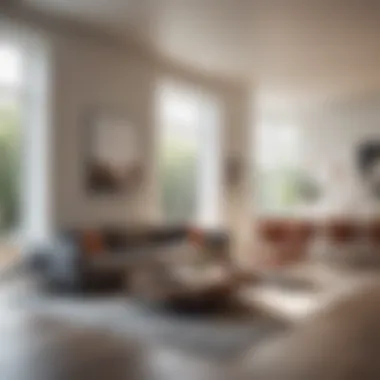The Paramount Soma: Exploring Space and Aesthetic Impact


Intro
The relationship between living spaces and human experience holds profound importance in our lives. Architecture and design go beyond mere aesthetics; they influence how we feel and interact within different environments. The concept of the paramount soma encapsulates this intricate connection, blending the essence of space with human perception. In this article, we examine how the physical characteristics of our surroundings impact our mental and emotional states. We will explore residential designs, architectural styles, and the aesthetic choices that contribute to our understanding of beauty and functionality.
Home Design Inspiration
Living spaces serve as the backdrop for our daily lives. They reflect our values, aspirations, and personalities. To delve deeper into this subject, we can examine various aspects of home design that inspire individuals to create their ideal environments.
Architectural Styles
Architectural styles shape the visual identity of buildings and influence their functionality. Here are a few notable styles:
- Modernist: Characterized by minimalism and simplicity, emphasizing open spaces and natural light.
- Victorian: Known for its intricate details, vibrant colors, and elaborate ornamentation.
- Mid-Century Modern: Features clean lines and organic forms, gracefully merging indoor and outdoor spaces.
- Industrial: Utilizes raw materials like metal and wood, creating an urban, edgy aesthetic.
Each architectural style has distinct characteristics that can evoke specific feelings and thoughts. Understanding these can empower individuals to make informed choices in their design preferences.
Innovative Decor Trends
The world of interior design constantly evolves. Emerging trends highlight the importance of personalization and sustainability. Here are some trends to consider:
- Biophilic Design: Integrating nature within interiors to enhance well-being.
- Sustainable Materials: Incorporating eco-friendly materials in home design decisions.
- Smart Home Technology: Utilizing technology to create convenient and efficient living environments.
These innovative trends emphasize the need for thoughtful choices that can enhance beauty and functionality in our spaces.
Stunning Locations
Exploring architectural excellence globally unveils a diversity of stunning locations. Each place provides unique insights into how design and environment affect human experience.
Top Global Destinations
There are remarkable places known for their architectural brilliance. Some noteworthy destinations include:
- Barcelona, Spain: Famed for Antoni Gaudí’s works like the Sagrada Familia.
- Tokyo, Japan: Features a blend of traditional and contemporary architectures, like the Meiji Shrine and Tokyo Skytree.
- Paris, France: Renowned for its historical landmarks, including the Eiffel Tower and the Louvre Museum.
These cities not only showcase extraordinary structures, but they also represent the fusion of culture and architecture.
Hidden Gems Around the World
In addition to well-known destinations, there are lesser-known locations that exemplify beautiful architecture. Some hidden gems include:
- Luang Prabang, Laos: A UNESCO World Heritage site, showcasing traditional Lao architecture.
- Ghent, Belgium: A picturesque city with medieval buildings and modern installations.
- Ohrid, North Macedonia: Known for its ancient sites and lakeside beauty, blending history with scenic architecture.
By uncovering these hidden gems, we gain a more profound appreciation for the diversity in architectural design.
"Architecture is not just about building; it’s about creating a space that resonates with the human experience."
Understanding the Concept of the Paramount Soma
The concept of the paramount soma is crucial to understanding the meaningful connection between spaces and human experiences. This exploration delves into how our environments shape our emotions, thoughts, and behaviors. Recognizing the significance of space in our lives helps to appreciate how architectural designs influence our daily experiences. Through this lens, we can analyze not only aesthetic aspects but also the functional implications spaces have on our wellbeing.
Definition and Origin of 'Soma'
The term 'soma' originates from ancient Greek, meaning "body." In contemporary discourse, it signifies the physical embodiment of existence as well as the relationship between our surroundings and ourselves. The paramount soma emphasizes that our bodily experiences are informed by the architecture we navigate.
The physiological response to space plays a vital role in how we connect to our environment. For instance, open spaces tend to evoke feelings of freedom, while confined areas may lead to discomfort. Understanding this interplay begins with recognizing that every design choice carries weight, shaping our experience within those spaces.
The Importance of Space in Human Experience
Space is more than just an empty area; it is a canvas for our interactions and experiences. The arrangement, scale, and proportions of places deeply influence how we feel within them. Here are some key points to consider:


- Emotional Influence: The design of a space can evoke various emotions. Spacious settings may generate calmness, while crowded environments often create tension.
- Social Dynamics: Layout affects social interaction. Public spaces encourage community gatherings, while isolated designs may hinder connections.
- Cultural Reflection: Architectural styles often reflect cultural values and traditions. Spaces embody the collective identity of communities.
Understanding these elements clarifies why space is fundamental to human existence. It serves as a backdrop for our lives, influencing everything from our daily tasks to our profound moments. The paramount soma invites us to engage critically with that relationship, enhancing our awareness of the spaces we inhabit.
Architectural Perspectives on Space
Architectural perspectives on space examine how built environments influence human behavior, experiences, and emotions. This section delves into various factors that contribute to the aesthetic impact of architecture while considering both form and function. The relationship between a space's design and its psychological effects cannot be overstated, as it shapes how individuals interact with their surroundings.
Defining Beauty in Architecture
Beauty in architecture is not merely a subjective notion. It is a complex interplay of design principles, materials, and context. Factors such as symmetry, scale, and proportion play critical roles in defining beauty. Additionally, the aesthetic appeal of a structure can vary widely based on its surroundings. For instance, a minimalist building in an urban environment might evoke different feelings than the same design nestled among nature.
The concept of beauty aligns with cultural perceptions as well. Different societies have unique tastes and traditions that shape their architectural styles. For instance, the ornate details of Baroque architecture contrast sharply with the simplicity of Scandinavian design. A deep understanding of these variances aids architects and designers in creating spaces that resonate with their intended audience, ultimately enhancing the user experience.
The Functional Aesthetics Approach
The functional aesthetics approach merges beauty with utility. It recognizes that while a space should be visually pleasing, it must also serve its intended purpose effectively. This balance is essential as it impacts how occupants use and interact with the space. For example, an office designed with employee collaboration in mind should incorporate open spaces along with areas for privacy.
Incorporating elements like flexible layouts and ergonomic furniture enhances both the functionality and aesthetic appeal of a workspace. This approach leads to environments where people not only feel comfortable but are also more productive. By prioritizing both beauty and function, architects contribute to the overall satisfaction of individuals within these spaces.
Sustainability and the Aesthetic Paradigm
Sustainability is an integral aspect of modern architecture, blending aesthetic values with an ethical responsibility toward the environment. Designing with sustainability in mind often involves selecting eco-friendly materials and energy-efficient systems. This not only has a positive impact on the environment but also influences the overall beauty of the space.
Architecture can promote a sense of harmony with nature. The use of natural light, incorporation of greenery, and materials that blend seamlessly with their environment can transform a space. Consider buildings like the Bosco Verticale in Milan, where high-rise structures covered in greenery redefine urban living while making a strong aesthetic statement.
Sustainability creates beauty that stands the test of time. It reflects a commitment to our planet and enhances human experience in profound ways.
Understanding the importance of architectural perspectives on space allows for a better appreciation of how design shapes our interactions with the world. By acknowledging elements such as beauty, function, and sustainability, architects can create environments that elevate the human experience and provide lasting impact.
Psychology of Space
The psychology of space is crucial in understanding the profound effects that our environments have on human experience. It emphasizes how various elements of design, layout, and aesthetics interact with our emotions, behaviors, and overall well-being. Through thoughtful exploration of the psychology of space, one can appreciate why certain spaces evoke feelings of calmness, inspiration, or even anxiety. This area of study underscores the importance of designing spaces that align with human psychological needs, which leads to increased functionality and satisfaction in those environments.
How Space Affects Mood and Behavior
Space does not simply serve as a backdrop for human activities; it actively shapes our mood and behavior. Research shows that open spaces can encourage social interaction, while confined areas may induce feelings of stress. The layout of a space influences how individuals engage with their environment. For instance, in urban settings, parks and open public spaces are linked to positive social interactions. Access to nature can lower stress levels and enhance our mood, which is known as restorative environments. Therefore, creating spaces that foster connection and peace is not just beneficial but essential.
The Role of Color and Light in Spaces
Colors and lighting are powerful tools in space design. Different colors can evoke various emotional responses. For example, blue often brings a sense of tranquility, while red can elicit excitement. In contrast, poor lighting can dampen mood, making a space feel unwelcoming. Natural light, in particular, contributes to happiness and productivity. Integrating large windows or skylights in design maximizes sunlight exposure, comforts the mind, and can boost energy levels. In contrast, dimly lit areas may lead to feelings of lethargy or sadness. Thus, understanding the psychological impact of color and light can significantly improve space usability.
Spatial Perception and Human Interaction
Spatial perception refers to how we perceive the space around us and its effect on our interactions. This concept takes into account personal space, crowding, and layout. Individual comfort levels vary, and what feels open to one person might feel constricted to another. Additionally, the arrangement of furniture influences how people interact within a space. For example, a circular seating arrangement encourages engagement, while a linear setup can foster separation. Designers must consider these nuances to create environments that promote positive interactions among users. By doing so, they can transform spaces into nurturing and enriching places for individuals to thrive.
"The environment often reflects our state of mind; thoughtfully designed spaces can, therefore, stimulate a better psychological outlook."
The Integration of Nature in Design
The integration of nature in design reflects a profound commitment to creating environments that resonate with the human condition. This concept extends beyond aesthetic appeal; it encompasses principles that enhance the functionality, health, and emotional well-being of individuals. Nature serves as both a backdrop and a fundamental component in architectural design. Through this integration, spaces can promote a sense of calm, connectivity, and sustainability.
The process of incorporating nature involves various elements, including natural materials, green spaces, and views of the outdoors. These components not only fulfill aesthetic desires but also improve the overall quality of life for occupants. Significant attention must also be paid to the local climate and ecosystem to ensure designs encourage biodiversity and respect environmental contexts.
This emphasis on nature in architectural and interior design relates closely to the idea of creating a harmonious relationship between built environments and their natural surroundings. Such sensitivity fosters a connection to the environment, inviting a deeper appreciation of the world we inhabit.
Biophilic Design Principles
Biophilic design draws from humanity's innate connection to nature, emphasizing the importance of natural elements in our living and working environments. Implementing biophilic principles can manifest through several strategies, including:


- Use of Natural Light: Maximizing natural light reduces energy consumption and boosts well-being.
- Incorporation of Plant Life: Using plants not only enhances aesthetics but also improves air quality.
- Natural Materials: Wood, stone, and other organic materials can create a warm, inviting atmosphere.
- Water Features: The sound and sight of water promote relaxation and tranquility.
- Views of Nature: Access to views of the outdoors supports mental health and cognitive function.
Effectively applying these principles can result in environments that encourage physical and mental restoration, ultimately forming spaces that nurture both inhabitants and their surroundings.
Impact of Natural Elements on Wellness
The impact of natural elements on wellness cannot be overstated. Research suggests that exposure to nature contributes significantly to our psychological and physical health. Natural elements offer benefits like:
- Stress Reduction: Observing natural scenes has been shown to lower stress levels, promoting a calmer state of mind.
- Enhanced Mood: Access to nature increases feelings of happiness and well-being.
- Improved Focus: Environments that include natural elements can boost concentration and productivity.
- Physical Health Benefits: Engaging with nature, whether through gardens or access to parks, promotes physical activity and encourages a healthier lifestyle.
"Integrating nature into design is not merely a trend but a fundamental necessity for fostering holistic well-being."
The acknowledgment of nature's influence on wellness strengthens the argument for its integration into design. With each element considered, architects and designers can create spaces that not only please aesthetically but also support the health of their occupants.
Case Studies in Residential Architecture
Case studies in residential architecture serve as critical illustrations of how designs respond to social, cultural, and environmental factors. By examining specific examples, readers gain insight into the complexities of creating living spaces that meet various aesthetic and functional needs. This analysis not only highlights successful design solutions but also underscores the lessons learned from failures and challenges. As a result, these case studies are invaluable for both practitioners and enthusiasts.
Contemporary Homes and Their Design Journeys
Contemporary homes showcase a variety of design philosophies. Each home tells its own story, reflecting the aspirations and lifestyles of its occupants. For example, the use of open floor plans encourages social interaction while allowing natural light to permeate spaces. Innovative materials, such as sustainable wood or recycled metals, contribute to both aesthetic appeal and environmental responsibility.
Key elements of these design journeys include:
- Adaptability: Modern homes often incorporate flexible spaces that can serve multiple functions.
- Integration with Nature: Large windows and outdoor living areas bring nature indoors, enhancing the emotional connection with the environment.
- Technological Advancements: Smart home technology is increasingly integrated into design, offering convenience and efficiency.
These features not only improve quality of life but also establish a deeper connection to the surrounding community and ecosystem.
Cultural Influences on Home Design
Cultural context plays a pivotal role in shaping residential architecture. Different regions reflect diverse traditions, beliefs, and materials, contributing to unique architectural styles. For instance, in many Asian cultures, the emphasis is often on harmony with nature and the use of natural materials. In contrast, Scandinavian design promotes minimalism and functionality while embracing sustainability.
Considerations in cultural influences include:
- Local Materials: The use of indigenous resources not only preserves cultural identity but also maintains ecological balance.
- Design Symbols: Architectural elements derived from cultural heritage can infuse meaning into a home, making it a sanctuary that resonates with its inhabitants.
- Community Integration: Homes that reflect community values encourage cohesion and social interaction among residents.
These cultural considerations enrich the dialogue between architecture and its environment, resulting in spaces that are both meaningful and beautiful.
Renovation Projects and Aesthetic Renewal
Renovation projects offer opportunities for aesthetic renewal, breathing new life into outdated structures. They present unique challenges, such as preserving historical elements while integrating modern design. These projects often reveal how adaptive reuse can transform spaces, providing fresh functionality without discarding the past.
Benefits of renovation include:
- Sustainability: Renovating existing structures reduces waste and energy consumption compared to new builds.
- Cultural Preservation: Retaining historic features connects current generations with their heritage.
- Personalization: Homeowners can tailor renovations to reflect their tastes, prioritizing functionality and comfort.
Ultimately, renovation projects exemplify how thoughtful design can revitalize spaces, fostering a sense of continuity within a rapidly changing world.
"The evolution of residential architecture reflects not only individual preferences but also broader societal shifts. Each case study reveals layers of complexity within the seemingly simple decision of how to dwell."
Exploring Extraordinary Locations
Exploring extraordinary locations is a vital part of understanding the intersections between architecture, environment, and human experience. Locations that are architecturally significant often evoke a strong emotional response in individuals, transcending mere functionality. These sites can inspire creativity, foster a sense of belonging, and promote cultural exchange. As we investigate these spaces, we notice that they influence both our mindset and our physical interactions with the environment. In this segment, we engage with extraordinary architectural marvels, environmental considerations, and cultural significances.
Architectural Wonders Around the World
Architectural wonders are not merely structures; they encapsulate the aesthetics, innovations, and cultural values of their respective societies. Sites like the Eiffel Tower in Paris, Taj Mahal in India, and Sydney Opera House in Australia showcase human creativity and technical prowess.
These architectural wonders often serve as symbols of national identity and pride. Each one tells a story reflecting the time of its creation. The Colosseum in Rome embodies the ingenuity of ancient engineering while serving as a remnant of Rome's grandeur. By studying these structures, one gains insight into historical contexts and cultural narratives, enriching the overall perception of architecture as an art form.


Benefits of exploring such sites include:
- Understanding Cultural Histories: Each wonder reflects cultural stories and collective memories.
- Inspiration for Design: Lessons from the past can inform contemporary architectural practices.
- Tourism and Economy Boost: Iconic sites often attract millions, benefiting local economies.
Environmental Considerations in Location Design
Environmental considerations in architectural design are critical for sustainability. Architects must think about how a structure will impact its surroundings. This includes understanding climate, local materials, and the ecosystem of the area.
For instance, projects in coastal areas must consider rising sea levels, whereas those in mountainous regions may need designs that withstand heavy snowfall. By favoring locally sourced materials, architects can reduce the carbon footprint of their constructions. Moreover, integrating green spaces within urban environments can help mitigate heat islands and enhance biodiversity.
Key elements to consider include:
- Climate Adaptation: Adjusting designs to withstand local weather patterns.
- Biodiversity: Protecting local flora and fauna during construction.
- Resource Management: Efficient use of water, energy, and materials in building processes.
Cultural Significance of Iconic Sites
Icons like the Great Wall of China and Machu Picchu do more than just attract tourists. They hold deep cultural significance for the societies from which they originate. These locations often symbolize resilience, heritage, and shared values.
Understanding their impact helps realize how spaces can influence collective memory and identity. Visiting these sites offers not only a glimpse into the past but also an understanding of ongoing cultural narratives. People engage with these sites, strengthening their connection to history and identity.
In summary, extraordinary locations serve as a canvas for exploration and discovery. They reveal insights into architectural innovation, environmental responsibility, and cultural narratives, enriching our understanding of spaces and their aesthetic impacts.
The Future of Space Design
The future of space design embodies a critical examination of how architecture can adapt to the rapidly changing needs of society. This topic matters because it bridges the gap between practical functionality and aesthetic appeal. Urbanization, environmental challenges, and advances in technology reshape how we think about living and working spaces. Design must respond not only to the physical form but also to the emotional and psychological needs of the inhabitants.
In today's world, design is no longer solely about creating visually appealing structures. It also involves understanding human behavior and comfort. The impact can be seen in various domains—residences, workplaces, and public spaces. With the changes in lifestyle, especially due to the pandemic, there has been a greater focus on flexibility and multifunctionality in designs. This reduces wasted space and enhances usability.
Technological Innovations in Architecture
Technology plays a pivotal role in shaping the future of space design. Emerging tools and methods transform the way architects approach building projects. For instance, innovations such as 3D printing, Building Information Modeling (BIM), and virtual reality enable designers to create and visualize spaces more effectively.
- 3D Printing allows for rapid prototyping, enabling architects to create physical models of their designs quickly and efficiently.
- BIM fosters collaboration among architects, engineers, and construction teams, reducing delays and errors in the building process.
- Virtual Reality offers immersive experiences that let clients visualize spaces before they are constructed, leading to highly informed decisions.
Moreover, sustainable building practices are now facilitated by technology. Smart materials can adapt to their environment. For example, self-healing concrete extends the lifespan of a structure, while photovoltaic glass generates energy.
"Architectural innovation is no longer just about aesthetics; it is fundamentally intertwined with technology and sustainability."
The Changing Needs of Modern Habitats
As our lifestyles evolve, so do the requirements for living spaces. The demand for comfort, efficiency, and adaptability drives this change. Factors such as remote work, urban density, and shifts in family structures necessitate new approaches to architecture.
Many modern homes now incorporate:
- Open Floor Plans to maximize space and improve functionality.
- Flexible Spaces that serve multiple purposes, reflecting the needs of families who work, study, and relax in their homes.
- Outdoor Integration to promote well-being and a connection to nature, which has become increasingly valued in recent times.
Furthermore, as cities continue to grow, there is an urgent need for eco-friendly designs that minimize environmental impact. Designs must consider energy efficiency, use of sustainable materials, and the promotion of green spaces. The future landscape of urban design pivotly encompasses these changing human needs—integrating technology, sustainability, and a focus on quality of life.
Finale: The Evolving Dialogue between Space and Human Experience
The relationship between space and human experience is not static; it evolves as society and culture change. Understanding this dialogue is crucial for several reasons. Firstly, design is not merely about aesthetics; it shapes how individuals interact with their environment. The choices made in architectural and interior design impact emotions, behaviors, and even relationships. Spaces inform the way we live, work, and connect with others. Thus, a thoughtful approach to design contributes significantly to well-being and functionality within those spaces.
Reflecting on the Importance of Design
Design serves as a pivotal element in how we perceive our surroundings. When spaces are thoughtfully designed, they elevate mundane experiences to something meaningful. For instance, public parks with pathways that encourage strolls foster connections amongst individuals. Homes designed with natural light in mind can make residents feel more content and energized. These elements impact mental states, creating environments that promote positive feelings.
Consider how the layout of a room can influence interactions. Furniture arrangement can encourage conversation or, conversely, create barriers. Hence, the importance of design is underscored not only by visual appeal but also by its potential to enhance human connection and comfort. Spaces can become extensions of our identities when they reflect our values and activities.
Encouragement for Thoughtful Exploration
It is essential to approach the concept of space with curiosity and openness. Each location holds stories and experiences that contribute to its aesthetic impact. By exploring diverse environments—whether residential, commercial, or natural—you gain insights into the intricate ways architecture influences our lives.
Engaging with various designs can deepen appreciation. Evaluate your surroundings: what works well? What seems out of place? Reflecting on these observations can lead to more informed choices in personal or professional spaces.
Moreover, as concerns regarding sustainability and environmental responsibility grow, understanding the impact of design decisions becomes increasingly significant. Engaging with ecological and social aspects of architecture may yield designs that are not only beautiful but also sustainable and ethically sound.







